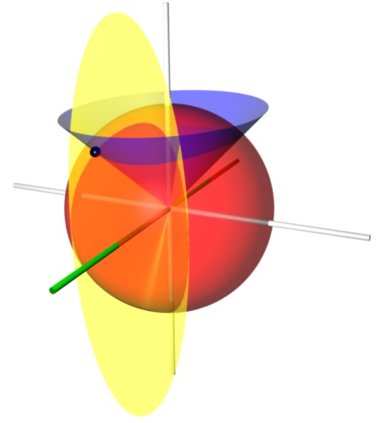
Conical coordinates
Encyclopedia

Orthogonal coordinates
In mathematics, orthogonal coordinates are defined as a set of d coordinates q = in which the coordinate surfaces all meet at right angles . A coordinate surface for a particular coordinate qk is the curve, surface, or hypersurface on which qk is a constant...
coordinate system
Coordinate system
In geometry, a coordinate system is a system which uses one or more numbers, or coordinates, to uniquely determine the position of a point or other geometric element. The order of the coordinates is significant and they are sometimes identified by their position in an ordered tuple and sometimes by...
consisting of
concentric spheres (described by their radius
 ) and by two families of perpendicular cones, aligned along the z- and x-axes, respectively.
) and by two families of perpendicular cones, aligned along the z- and x-axes, respectively.Basic definitions
The conical coordinates are defined by
are defined by


with the following limitations on the coordinates

Surfaces of constant
 are spheres of that radius centered on the origin
are spheres of that radius centered on the origin
whereas surfaces of constant
 and
and  are mutually perpendicular cones
are mutually perpendicular cones

In this coordinate system, both Laplace's equation
Laplace's equation
In mathematics, Laplace's equation is a second-order partial differential equation named after Pierre-Simon Laplace who first studied its properties. This is often written as:where ∆ = ∇² is the Laplace operator and \varphi is a scalar function...
and the Helmholtz equation
Helmholtz equation
The Helmholtz equation, named for Hermann von Helmholtz, is the elliptic partial differential equation\nabla^2 A + k^2 A = 0where ∇2 is the Laplacian, k is the wavenumber, and A is the amplitude.-Motivation and uses:...
are separable.
Scale factors
The scale factor for the radius is one (
is one ( ), as in spherical coordinates. The scale factors for the two conical coordinates are
), as in spherical coordinates. The scale factors for the two conical coordinates are


